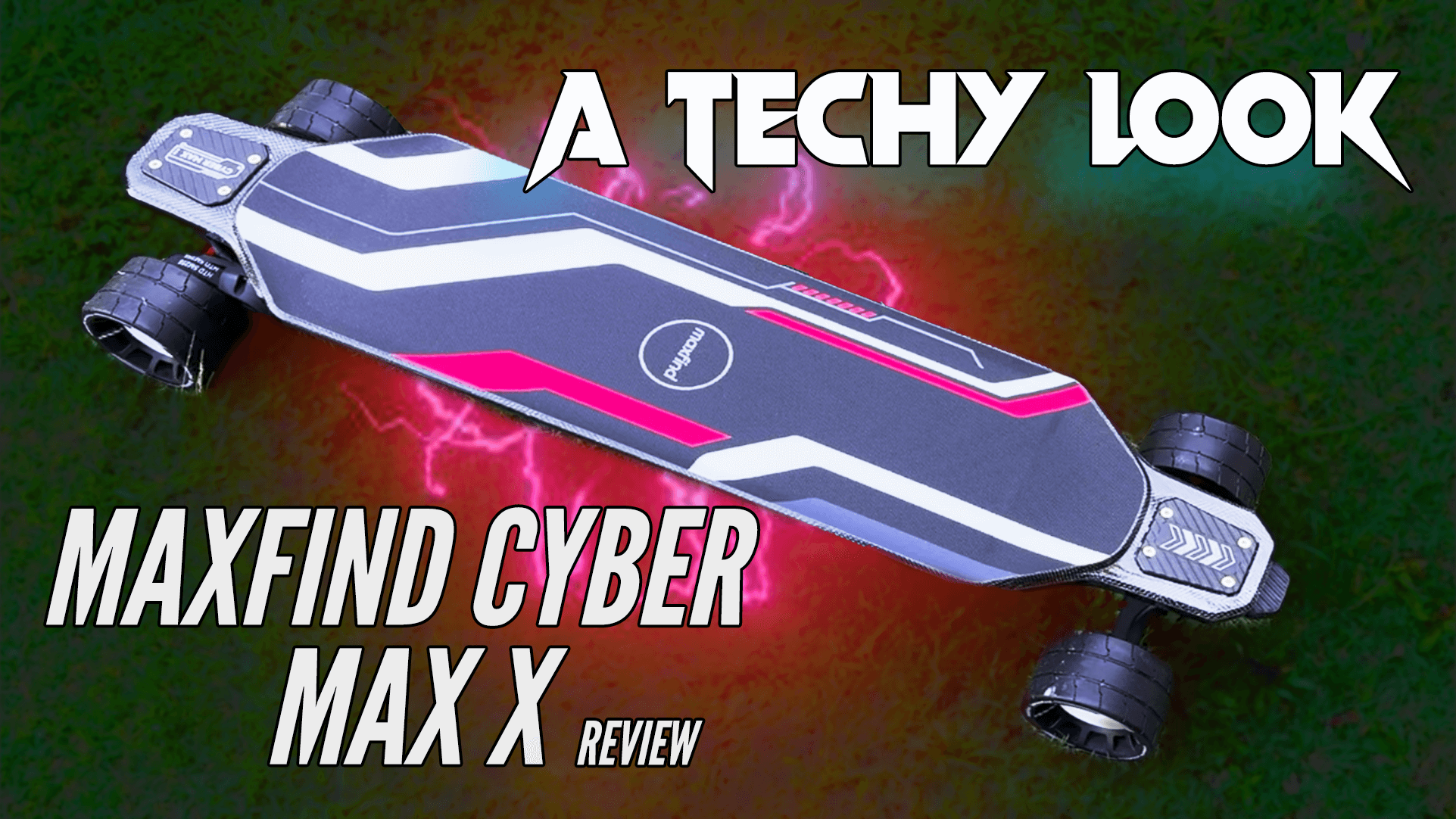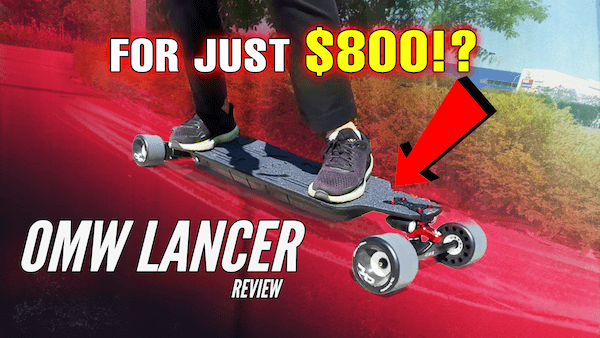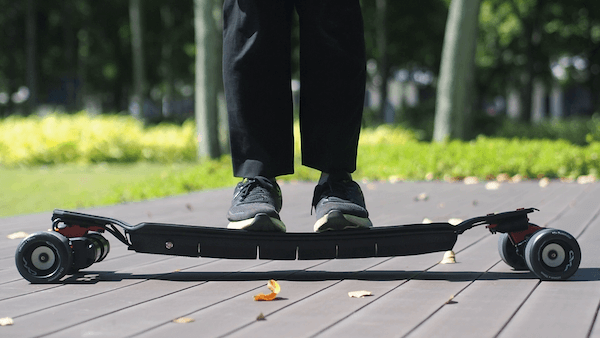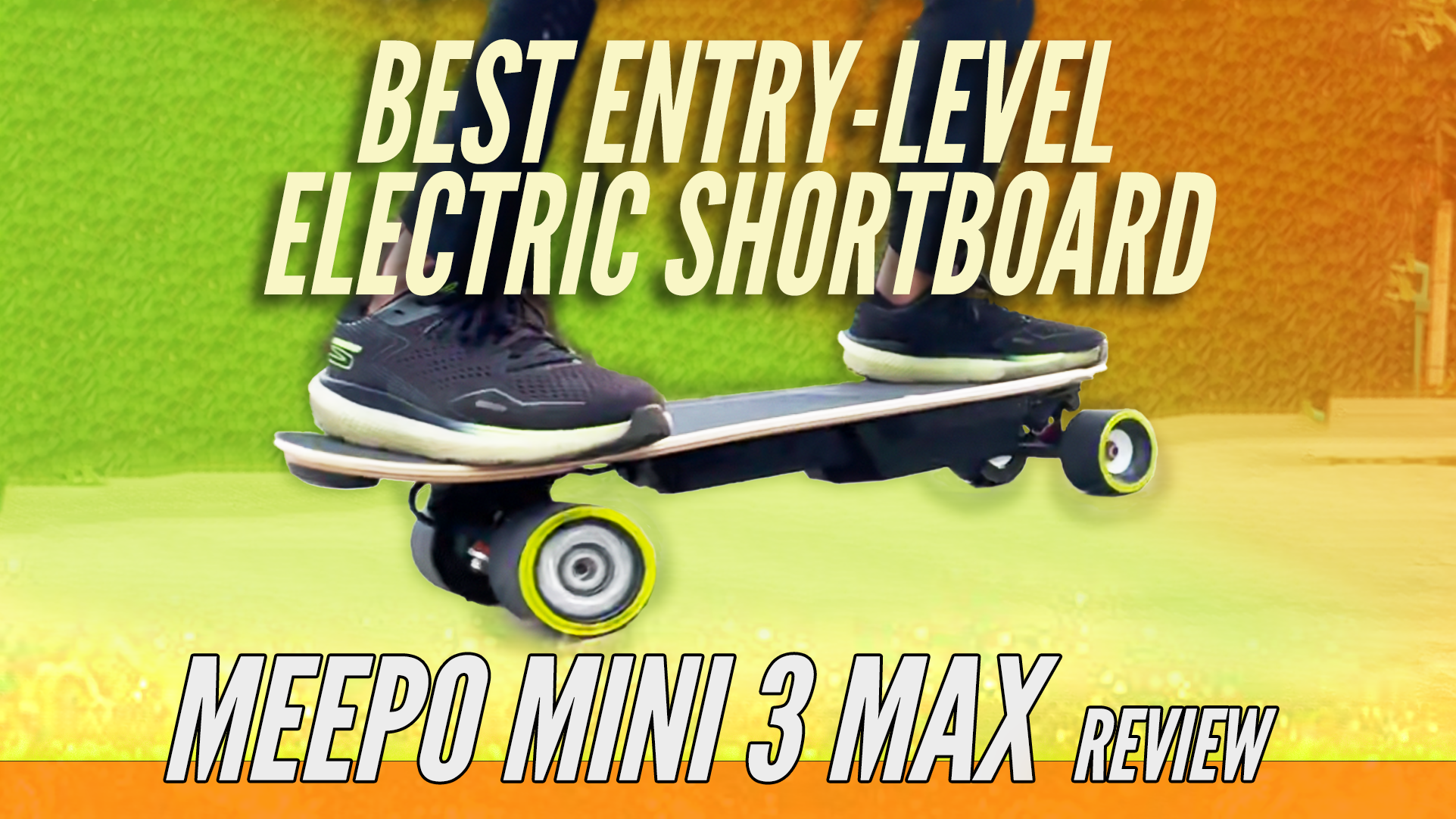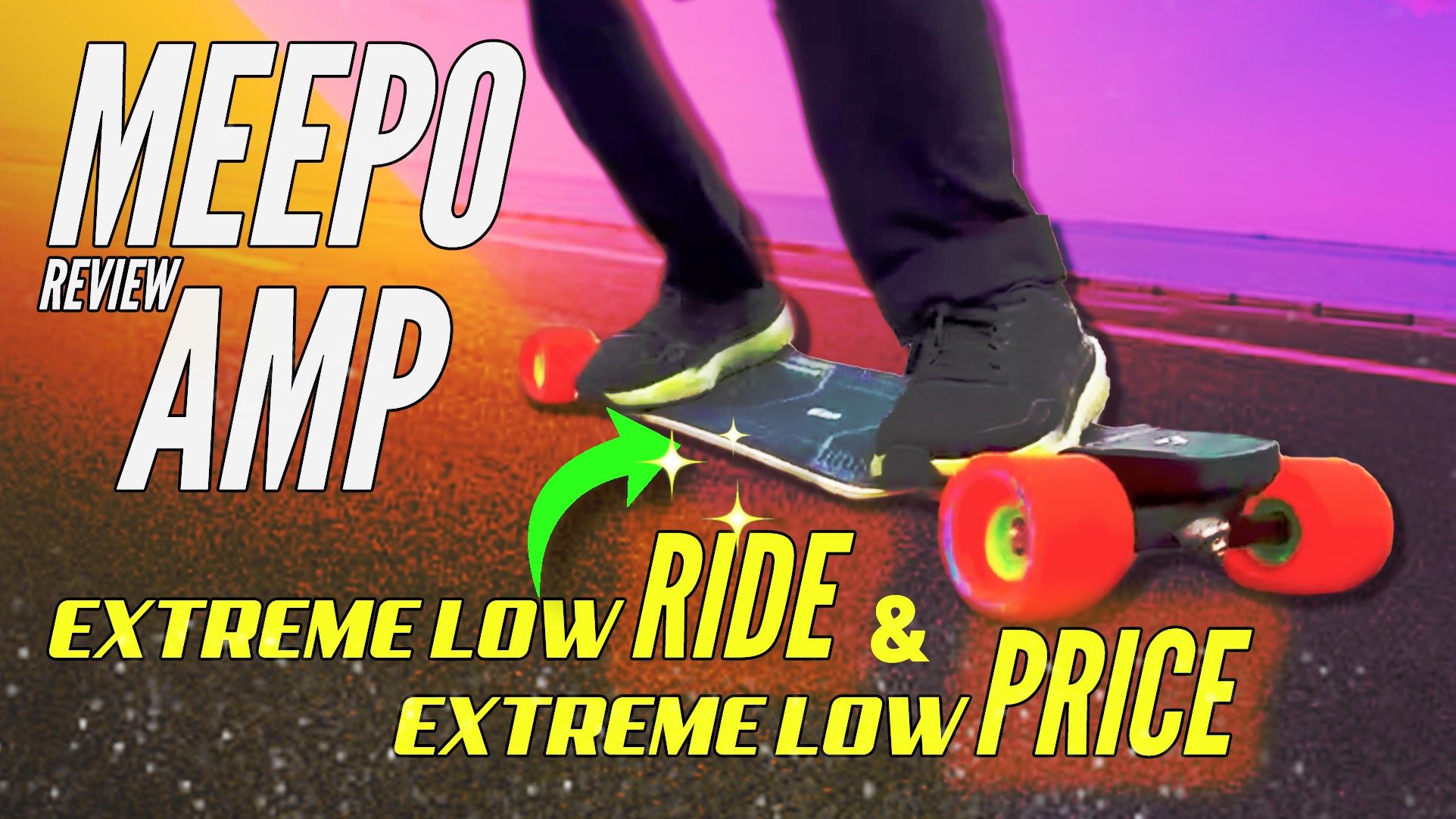If there’s one thing about Maxfind; it’s that they’re always pretty bold when it comes to how their skateboards look. This is no different for the Maxfind Cyber Max X, which is priced at $849 and is currently positioned as Maxfind’s flagship belt-drive longboard.
It’s a 12s belt-driven setup with larger 107mm wheels, and it retains the RGB lighting flair that Maxfind introduced with the Max 6 series.
Competition in the mid-range segment — which we’ve defined as $500 to $1000 — is pretty stiff, so let’s see if the Cyber Max X has what it takes to be a worthy consideration.
Let’s get into the details.
Maxfind Cyber Max X Specs:


| Price | $849 |
| Battery | 415Wh 12s2p Samsung 21700 40T |
| Controller | Hobbywing with 4 Speed Modes + App |
| Top Speed | 31 mph / 50 km/h |
| Range | 37 miles / 60 km |
| Deck | 38″ Composite + Fiberglass, Rubber Grip, Slight Double Drop |
| Motor | Dual 1800W Belt-drive |
| Weight | 24.2 lbs / 11 kg |
Deck – 38″ Composite + Fiberglass, Rubber Grip, Slight Double Drop:


If you’re familiar with Maxfind’s longboards, you’ll immediately recognize the design here. The Cyber Max’s deck measures 38″ long and 11″ wide, with a mild double drop profile that lowers your center of gravity for extra stability. It also features a deep concave, which locks your feet in nicely and adds to overall control and comfort when riding.
Maxfind calls it a Flex Composite Deck, built from PPS composite — a flexible polymer that offers surprising flex, despite its carbon-fiber-like stiffness in appearance. The cyberpunk-inspired graphic completes the futuristic vibe.
To top it off, literally, the top of the deck is lined with rubberized griptape, which provides better grip than we initially expected, and unlike sandpaper grip tape, it won’t accidentally catch or destroy fabrics.
Below the deck, there’s a carbon fiber coating that improves scratch resistance and gives the deck a sleek matte-satin finish. The material is also 100% recyclable, if that’s something you value.
And like the Max 6, this is a unibody deck, meaning the electronics enclosure is integrated into the deck itself. That adds both style and function, helping to keep out water and dust from underneath; contributing to the board’s IPX5 water resistance rating.
Finally, the familiar RGB ambient lighting runs along the sides of the deck. Just like on the Max 6, it’s not super bright, but it adds a stylish glow and improves nighttime visibility.
Battery – 415Wh 12s2p Samsung 21700 40T:


Next, fuelling the Cyber Max X is a 12s2p Samsung 21700 battery, rated at 415Wh.
While Chinese battery cells have become more affordable lately, Maxfind chose to stick with Samsung cells for the Cyber Max — a decision that could pay off in terms of battery longevity and reliability.
In terms of value, 415Wh at $849 is fair. It’s not the biggest battery you can find in this price range, but it’s definitely not the smallest either.
And, the range should satisfy most riders. Maxfind markets the Cyber Max X with a 37 miles (60 km) range on a single charge. You could probably reach that distance if you ride conservatively on 90mm wheels, or coast efficiently on the 107mm Spacewheels.
In our experience, a realistic range estimate is around 28 miles (45 km) when riding fast on the 107mm wheels — which is still plenty for daily use and group rides.
Also, a 3A UL-certified fast charger is included, which will fully charge the board in 3 hours.
ESC and Remote – Hobbywing with 4 Speed Modes + App:


For the ESC, Maxfind went with the tried-and-true Hobbywing ESC, which means you can expect smooth acceleration and predictable braking — exactly what we’ve come to expect from Hobbywing setups.
The remote is likely the standard Hobbywing unit in a custom Maxfind casing. It includes a screen for telemetry, comes with four speed modes, and can be paired with the Tuya mobile app to customize your ride profile and settings.
Motors – Dual 1800W Belt-drive:


As for the motors, the Cyber Max X uses a set of dual 1800W belt-drive motors. Which is a modest number by today’s standards, but as we always say — motor wattage doesn’t always translate to real-world performance. The board has a marketed top speed of 31 mph (50 km/h), and it does get there eventually. In our test rides, acceleration felt strong but not outstandingly so.
The gear ratio here is 15:40, which gives just a 2.7 gear reduction — a setup that’s clearly optimized more for efficiency and top speed rather than explosive torque. With that said, the low-end torque is still decent, but unlike boards that are tuned to rocket off the line, the Cyber Max X isn’t going to throw you off the deck on launch.
It still gets up to around 28 mph fairly quickly, but the last stretch from 28 to 31 mph takes noticeably longer, with the power tapering off near the top end.
If you’re chasing torque, the 107mm Spacewheels are part of what’s holding it back. Based on the math, switching to 90mm wheels would give you around 15% more torque. So if you want a punchier ride or sharper braking, downsizing the wheels is a good option.
Wheels – 107mm Spacewheels (74A):


So, what about the wheels?
The 107mm Spacewheels are something new and proprietary from Maxfind — and we always appreciate brands that develop their own components instead of just plucking parts off the shelf.
These wheels are made from 74A urethane, which puts them on the softer side — and in testing, they did a decent job at absorbing road vibration. They’re definitely more comfortable than standard PU wheels, especially on longer rides or rougher pavement.
Being soft and wide, they also offer great grip, especially when carving or braking hard.
The larger diameter allows you to roll over small debris, short grass, and loose gravel without much trouble. Just don’t expect them to turn your board into an off-road machine — the Cyber Max X doesn’t have the torque or clearance for actual trail riding.
Trucks – Max III 12″ CNC-forged (Generic Maxfind Style):

The Cyber Max X comes with Maxfind’s own MAX III trucks — a 45° forged setup with a 12” hanger and 95A bushings. This configuration leans heavily toward high-speed stability, which fits the overall character of the board.
At this price point, we expect forged trucks to be standard. While not every mid-range board includes them, we believe they all should. Forged trucks are stronger and more durable than cast ones, and that matters when you’re riding close to 30 mph.
Performance-wise, the MAX III trucks are stable and confidence-inspiring, especially at higher speeds. Carving is fine — they’re not the most responsive, but they’re also not stiff or uncooperative. It’s a balanced setup that clearly favors control over agility.
The ride remains stable and predictable even at top speed, which is a trait more conservative or speed-focused riders will likely appreciate.
Specs Summary of the Maxfind Cyber Max:


There are brands that position themselves at the forefront of the price war — focused purely on delivering the biggest value for money; and Maxfind has never really been one of them.
As is often the case, Maxfind aims to differentiate themselves through unique design choices and higher- quality components and the Cyber Max X is no exception.
If you don’t like the look, don’t vibe with the unibody deck, or don’t want the larger 107mm wheels, then honestly — there’s little reason to consider the Cyber Max. This board isn’t trying to be for everyone.
But if the design speaks to you, and you’re into the styling, the build, and the feature set — then sure, let’s talk about how it rides.
Riding Experience of the Maxfind Cyber Max:


From the very first ride, it was clear that the Cyber Max X isn’t designed to be a high-adrenaline board. As we mentioned in the motor section, the board has the muscle and the battery to go fast, but it’s not tuned to be explosive. Going full throttle from a standstill won’t challenge your balance — instead, it gives you a smooth and steady ramp-up in speed, all the way to its top end.
Both acceleration and braking are well feathered and smooth, making this one of the easiest belt-drive boards to ride in this price range.
That ease carries over to the rest of the setup, too. The deck is comfortable, with a U-shaped concave that keeps your feet locked in, and just the right amount of flex to absorb some shocks. It’s not overly bouncy or unstable — just enough give to keep the ride comfortable without compromising stability at high speed.
The 107mm Spacewheels also play a big role in the riding experience. Sure, they take away some torque, but they also absorb a lot of road vibration and remove much of the stress from sketchy road conditions. Rolling over sticks, pebbles, or minor potholes isn’t a problem, which adds a layer of confidence and comfort that smaller wheels can’t offer.
Verdict on the Maxfind Cyber Max:


The Maxfind Cyber Max X is a very good board — one that we feel deserves a recommendation.
That being said, we wouldn’t be surprised if it ends up underappreciated. Most e-skaters in the midrange segment are chasing adrenaline, and this board isn’t trying to be that. Not many riders are out there specifically looking for a comfortable, relaxing cruise board at $849.
But if that’s exactly what you want — a smooth, stable ride with high-quality parts and excellent range — or if you’re a beginner looking for your first belt-drive board that won’t throw you off the moment you hit the throttle, then the Cyber Max X is definitely worth considering.
If you are interested in buying the Maxfind, be sure to check out our affiliate discount link here and use code: “ESKATEHQ” to receive $25 off during checkout.
It will help you get a small monetary discount and help us out too. On top of that, you’ll be tagged as an Electric Skateboard HQ customer and probably be treated better. Cheers!




